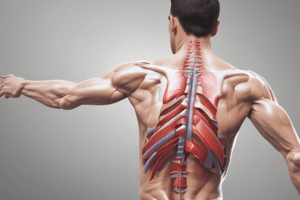Podcast
Questions and Answers
What is a joint dislocation?
What is a joint dislocation?
- A complete separation of two or more bones at an articulating joint (correct)
- A condition where the joint becomes stiff
- A fracture in the bone near a joint
- A partial separation of two or more bones at an articulating joint
Which of the following is a common cause of joint dislocations?
Which of the following is a common cause of joint dislocations?
- Sports injuries (correct)
- Arthritis
- Infection
- Osteoporosis
What is an important aspect of the clinical assessment for joint dislocations?
What is an important aspect of the clinical assessment for joint dislocations?
- Assessing for fever
- Evaluating for deformity and swelling (correct)
- Listening for lung sounds
- Checking blood pressure
When is open reduction typically performed for joint dislocations?
When is open reduction typically performed for joint dislocations?
What is used to immobilize the joint post-reduction?
What is used to immobilize the joint post-reduction?
Which joint is NOT mentioned as a frequently dislocated joint?
Which joint is NOT mentioned as a frequently dislocated joint?
What is the purpose of Total Knee Arthroplasty?
What is the purpose of Total Knee Arthroplasty?
What is the role of physiotherapy in Total Knee Arthroplasty?
What is the role of physiotherapy in Total Knee Arthroplasty?
What are some common challenges in physiotherapy after Total Knee Arthroplasty?
What are some common challenges in physiotherapy after Total Knee Arthroplasty?
What are the types of post-operative care after Total Knee Arthroplasty?
What are the types of post-operative care after Total Knee Arthroplasty?
What is the anatomy of the knee joint composed of?
What is the anatomy of the knee joint composed of?
What are some future advancements in total hip replacement?
What are some future advancements in total hip replacement?
What are the benefits of Total Hip Replacement?
What are the benefits of Total Hip Replacement?
How are alternatives to total hip replacement described in the text?
How are alternatives to total hip replacement described in the text?
What is the primary goal of early intervention in physical therapy for joint function?
What is the primary goal of early intervention in physical therapy for joint function?
Which complication may require immediate intervention in cases of severe dislocations with associated soft tissue injuries?
Which complication may require immediate intervention in cases of severe dislocations with associated soft tissue injuries?
What is the most common indication for total hip replacement surgery?
What is the most common indication for total hip replacement surgery?
Which component of hip replacement surgery may be cemented, press-fit, or uncemented?
Which component of hip replacement surgery may be cemented, press-fit, or uncemented?
What is the primary benefit of modern prosthetic hips?
What is the primary benefit of modern prosthetic hips?
Which potential risk following total hip replacement surgery may require revision surgery?
Which potential risk following total hip replacement surgery may require revision surgery?
Flashcards are hidden until you start studying
Study Notes
- Physical Therapy: Early intervention essential for joint function restoration, preventing stiffness, and strengthening surrounding muscles.
- Pain Management: Medications like analgesics and anti-inflammatory may be prescribed to manage pain and reduce inflammation.
- Complications and Considerations:
- Recurrent Dislocations: Some joints, like the shoulder, may require additional interventions to prevent dislocations.
- Neurovascular Compromise: Careful monitoring of neurovascular status to prevent nerve or blood vessel damage.
- Compartment Syndrome: Immediate intervention required in cases of severe dislocations with associated soft tissue injuries.
- Rehabilitation and Long-Term Follow-up:
- Gradual Range of Motion: Physical therapy focuses on restoring joint range of motion gradually and safely.
- Strength and Stability: Exercises essential to strengthen muscles and prevent future dislocations.
- Psychological Support: Patients may experience anxiety or fear of re-injury, counseling or support groups beneficial.
- Prevention:
- Protective Gear: Appropriate protective gear reduces the risk of joint dislocations in sports and high-risk activities.
- Safety Measures: Educating individuals about safety measures and fall prevention, especially in the elderly, is crucial.
Total Hip Replacement:
- History:
- Ancient Times: Artificial fingers made from bronze and gold attached with linen.
- 1800s: Surgeons developed joint prostheses but materials were not strong enough.
- 1940s to 1960s: Sir John Charnley developed the modern design for total hip replacement.
- Recent advances: Minimally invasive techniques and robotic-assisted surgeries.
- Indications:
- Osteoarthritis of the hip is the most common indication.
- Rheumatoid arthritis, injury/fracture, hip osteonecrosis, and neglected hip dislocation are also indications.
- Designs and components:
- Types of hip replacement surgery: Total hip replacement vs partial hip replacement (hemiarthroplasty).
- Femoral component: cemented, press-fit, or uncemented.
- Acetabular components: cemented, press-fit, or uncemented.
- Bearing surfaces: polyethylene, metal, or ceramic.
- Surgery techniques:
- Posterior approach: incision over the hip joint to expose the damaged bone and cartilage.
- Lateral approach.
- Direct anterior approach: muscle-sparing hip replacement.
- Surgery procedure:
- Incision: surgeon makes an incision over the hip joint.
- Preparation of the Joint: damaged bone is removed, and the socket and femur are shaped to fit the prosthesis.
- Implantation: prosthesis is inserted into the joint and secured with screws, cement, or both.
- Post-operative care: patient monitored for pain, infection, and mobility, physical therapy encouraged for recovery.
- Benefits and outcomes:
- Pain relief and mobility.
- Improved quality of life.
- Modern prosthetic hip can last up to 20 years.
- Risks and complications:
- Infection, implant loosening or wear damage, blood clots, and dislocation of the prosthetic joint.
- Close monitoring and revision surgery may be required.
Studying That Suits You
Use AI to generate personalized quizzes and flashcards to suit your learning preferences.




